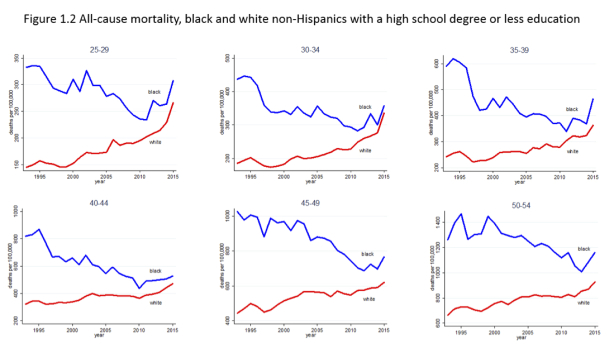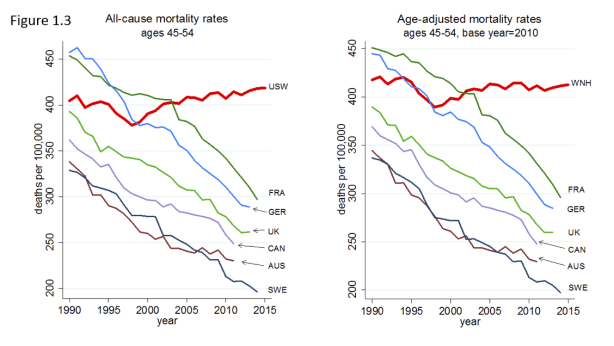From David Ruccio We don’t need Louisiana Detective Rodie Sanchez coming out of retirement to solve the crime against the members of the working-class currently being committed in the United States. We already know many of the details of the crime. We also know the identities of both the victims and the serial killer. The only real mystery is, what’s the country going to do about it? The investigation itself is being painstakingly carried out by Anne Case and Agnus Deaton (pdf). They show, with abundant statistics, that mortality trends in the United States run counter to those in other rich countries, where they have been steadily declining for decades. The headlines, of course, have been about one group—middle-age white non-Hispanics with a high-school degree or less—whose mortality rates, especially those attributed to “deaths of despair” (drug overdoses, suicides, and alcohol-related liver mortality), increased from 1998 through 2015.* The focus in on that group for a number of reasons, including the fact that increasing rates for them (as against blacks and nonwhite Hispanics) have all but erased the racial gap in mortality among non-college-educated Americans—and, of course, because of the prominence of “white working-class” voters in explanations of Donald Trump’s electoral victory.
Topics:
David F. Ruccio considers the following as important: Uncategorized
This could be interesting, too:
tom writes The Ukraine war and Europe’s deepening march of folly
Stavros Mavroudeas writes CfP of Marxist Macroeconomic Modelling workgroup – 18th WAPE Forum, Istanbul August 6-8, 2025
Lars Pålsson Syll writes The pretence-of-knowledge syndrome
Dean Baker writes Crypto and Donald Trump’s strategic baseball card reserve
from David Ruccio
We don’t need Louisiana Detective Rodie Sanchez coming out of retirement to solve the crime against the members of the working-class currently being committed in the United States.
We already know many of the details of the crime. We also know the identities of both the victims and the serial killer. The only real mystery is, what’s the country going to do about it?
The investigation itself is being painstakingly carried out by Anne Case and Agnus Deaton (pdf). They show, with abundant statistics, that mortality trends in the United States run counter to those in other rich countries, where they have been steadily declining for decades.
The headlines, of course, have been about one group—middle-age white non-Hispanics with a high-school degree or less—whose mortality rates, especially those attributed to “deaths of despair” (drug overdoses, suicides, and alcohol-related liver mortality), increased from 1998 through 2015.* The focus in on that group for a number of reasons, including the fact that increasing rates for them (as against blacks and nonwhite Hispanics) have all but erased the racial gap in mortality among non-college-educated Americans—and, of course, because of the prominence of “white working-class” voters in explanations of Donald Trump’s electoral victory.
But we also need to go beyond the headlines and understand that, while rates for different ethnic and racial groups in the United States have moved in opposite directions in recent decades, the rates for working-class blacks and Hispanics are still very high—and, in recent years (as can be seen, in the case of blacks, in the chart at the top of the post), they’ve also begun to rise.
That’s the real crime story. All three groups within the American working-class—whites, blacks, and Hispanics—are being killed at abnormally high rates compared to the populations of other rich countries.
And the serial killer? Case and Deaton have a much more difficult time working in this area. That’s because they follow the headlines and emphasize the differences in the long-term trend rates and lose sight of the larger picture. So, they discount the role played by income inequality and, instead, endorse Charles Murray’s story about the decline in traditional American virtues among working-class whites (which I wrote about back in 2012).
The fact is, the labor-market factors identified by Case and Deaton—which have negatively affected whites, blacks, and Hispanics with a high-school degree or less—have become more severe as inequality has soared and the social safety net ripped apart in the United States from the early 1970s onward. The upward trend for whites and the narrowing of the racial gap, as significant as they are, shouldn’t hide from view the more general problem (as I wrote about in 2015) of a large and growing gap between the life expectancies (for both men and women) of those at the top and bottom of the distribution of income in the United States.
American TV is currently captivating viewers with stories of people accused of committing horrific acts. It’s time, however, to focus on the story of an economic system that has created its own killing fields.
*Mortality increases for whites in midlife have also been paralleled by morbidity increases, including deteriorations in self-reported physical and mental health, and rising reports of chronic pain.


